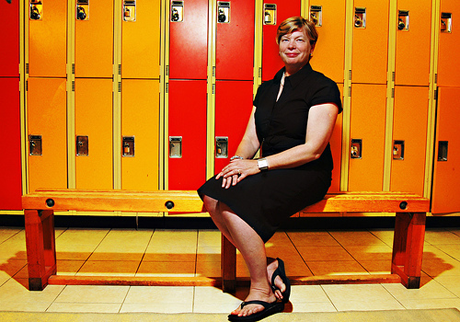
For years B.C.'s Liberal government has been bragging about the huge amounts of money it's pumped into the system. Premier Campbell has vowed to make this the best-educated province in Canada.
Yet the schools seem insatiable. No matter how much they get, it's never enough -- even though enrolments are dropping. School boards are always facing "budget challenges," closing schools and cutting programs. Parents, baffled by the contradiction, blame the usual suspects: incompetent trustees, lazy administrators, greedy teachers, and fat in the budget.
A new report exonerates those suspects, documenting consistent underfunding of B.C. schools since 2002, when the new Liberal government changed the way it pays for education.
Info from 45 school districts
"When More is Less" was produced by the Centre for Civic Governance at Columbia Institute, a B.C. think tank. The chief author is Charley Beresford, CEO of the CCG and former chair of the Greater Victoria school board. She and her research team contacted all 59 B.C. school districts and got information from 45 of them.
"When More is Less" cites studies that show growing fixed costs have more than erased any increased funding since the mid-1990s. One study argued that to return school funding in 2004 to the level of 1990, Victoria would have had to add $300 million to its education budget.
At this end of the decade, schools also face sharply higher spending for items like school-bus gasoline and fuel to heat buildings. As well, the Liberals have imposed costly new mandates for early learning, district literacy standards, the British Columbia enterprise Student Information Service, not to mention the carbon tax.
Boards have had to spend for all these items while legally forbidden from running a deficit. Some manage to do so, but the report found 32 out of 45 boards have run into trouble. To make ends meet, they've had either to cut programs and services, or to spend what they'd saved from previous years.
The report says: "Reductions in services to students with special needs, school closures and a variety of other cuts are just some of the ways the education system has been impacted. Moreover, there are troubling signs of inequity."
Fueling that inequity is the importing of international students. As in the 1990s, Asian students still come to B.C. for a good education, and we charge them the full cost. For Lower Mainland districts, those students are cash cows, but other districts can't attract them.
"Though education funding has increased nominally," the report says, "it has failed to keep pace with rising costs. To maintain British Columbia's global position as a leading education system, a review of the funding formula matched by a provincial commitment to adequate and stable funding is required."
True shortfall pegged at $135 million
The report puts the current shortfall for schools' operating budgets at $132 million, and says that's a "conservative" estimate: "The $132 million figure does not include additional cost pressures such as inflation or earlier labour settlements not covered by the province. If we could add those costs in as well, the shortfall would be much greater."
How did we get here?
As recently as 1980, school boards had their own taxing powers. If the province's funding wasn't enough, trustees could jack up the mill rate on local businesses and homeowners to get the money for needed local programs. If taxpayers didn't like it, they could fire the trustees in the next election.
In 1981-82, the Bill Bennett Socreds changed that formula by removing the power of trustees to tax commercial-industrial property. From then on, trustees could raise extra money from their residential taxpayers only.
The result was a step closer to achieving education funding equality in British Columbia, even though wealthier districts still had plenty of taxable residential property and could therefore run excellent programs beyond the means of rural districts.
At the cost of local autonomy, B.C. school boards eventually presided over districts that offered generally equal programs and levels of service. The money came from Victoria, whether the Socreds or the New Democrats were in power. Poor districts with special-needs students could support those students as well as districts like Vancouver and West Vancouver.
BC Liberals changed funding formula
In 2001, the Campbell Liberals changed the terms of education funding at all levels. In the public schools, as "When More is Less" makes clear, the formula now provided money mostly by counting students and allocating a set number of dollars per student in each district, rather than based on varying needs.
A demographic shift put boards in a bind. Enrolments, as the report says, had been declining since the late 1990s. Under the new Liberal formula, this meant less money over all.
"While it might be logical to assume that districts are able to reduce costs in proportion to the number of students enrolled," the report says, "the reality is that they can't."
Suppose you live in a mortgaged house with two children. One kid moves out, but your mortgage stays the same. Heat and light bills don't change much. Property taxes depend on the local housing market, not on the number of people under your roof.
So it is with schools.
As Charley Beresford says in the conclusion of the report: "Although total operating funding has increased, once a closer look is taken at the individual districts, it is clear that these increases do not cover the costs of education. The implication that more funding has meant more services for students does not bear out. In this case, 'more' is less."
"To maintain British Columbia's global position as a leading education system, a review of the funding formula matched by a provincial commitment to adequate and stable funding is required."
Related Tyee stories:
- How Province Erased $22 Million in School Funds
While finance minister brags of 'record' increase. - As BC's School Enrolment Drops
Why the dive, and the need for smart thinking. - Making Schools 'Carbon Neutral'
School officials scramble to meet BC emissions goal.















Tyee Commenting Guidelines
Comments that violate guidelines risk being deleted, and violations may result in a temporary or permanent user ban. Maintain the spirit of good conversation to stay in the discussion.
*Please note The Tyee is not a forum for spreading misinformation about COVID-19, denying its existence or minimizing its risk to public health.
Do:
Do not: